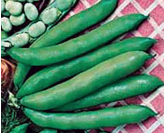Broad bean source of protein for animal feed
Abstract
legumes are considered food of high interest, particularly in countries where developing or underdeveloped pathways, where represent an important protein source for provide 20% of dietary protein consumed to world level, its contribution being between 10-50%, according to the continent (Deshpande and Deshpande,
2001). Legumes have an important place in the human diet, since they contain 2 to 3 times more protein than cereals. Both for low-income people and vegetarians,
they are the main source of protein.
Likewise, they have forage utility as they are consumed by cattle and different species of zootechnical interest; reasons that make these, a food alternative in the challenge of contributing with the sustainability of animal production systems. Its grains provide carbohydrates complexes, especially starch, also fiber, vitamins belonging to group B, minerals, as potassium, phosphorus, magnesium, zinc and especially iron and calcium (Dávila et al., 2003); and they are widely distributed worldwide in tropical and subtropical regions (Heywood, 1985). Of the legumes with forage potential we can Mention beans, canavalia, soybeans, forage peanuts, haba, among others.
References
Deshpande, U.S. and S.S. Deshpande. 2001. Legumes. In: Salunke and Deshpande (Ed.), Foods of Plant Origin. Production, Technology and Human Nutrition. England. 137-300 pp.
Hernández, G., I. Matute, D. Moreno, M. Araujo, L. Ramírez, H. Linares, Y. Arvelaéz, J. Loaiza, J. Monsalve y J. Palma. 2015. Valor nutricional de la harina de haba (Vicia faba L.) en la alimentación de alevines de Coporo (Prochilodus mariae) Revista Científica, FCV-LUZ/ Vol. XXV, N° 3, 255-259 pp.
Maya, K. 2009. Caracterización física, nutricional y no nutricional de haba sometida a tratamiento térmico. Trabajo de grado Maestría. México, D.F. Instituto Politécnico Nacional. Escuela Nacional de Ciencias Biológicas. 153 p.
Newman, C.W. 1986. Protein supplements for swine diets in the Western United States. In: Reports of the 27th Annual Swine Day. Agricultural Experiment Station Oregon State University, Corvallis. 771(1): 33-52 pp.
Partanen, K., T. Alaviuhkola, H. Silijander-Rasi and K. Suomi. 2013. Faba beans in diets for growing-finishinng pigs. Agricultural and Food Science in Finland 12(1):35-47 pp.
Rojas, J. 2011. Tecnología de producción de haba utilizada en comunidades de puebla y Tlaxcala, México, y características socioeconómicas de los productores. Tesis de Maestría. Institución de Enseñanza e Investigación en Ciencias Agrícolas. 68 p.
Tortuero, F., M. Rodríguez, J. Rioperez y R. Caballero, 1987. Empleo de habas (Vicia faba L. Minor) en dietas para gallinas ponedoras. Archivos de Zootecnia 36(135):157-164 pp.


